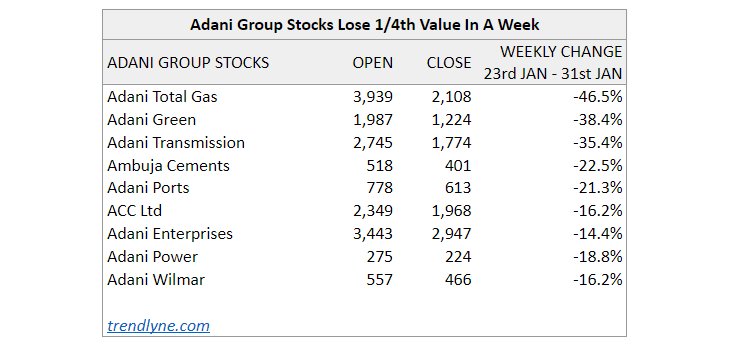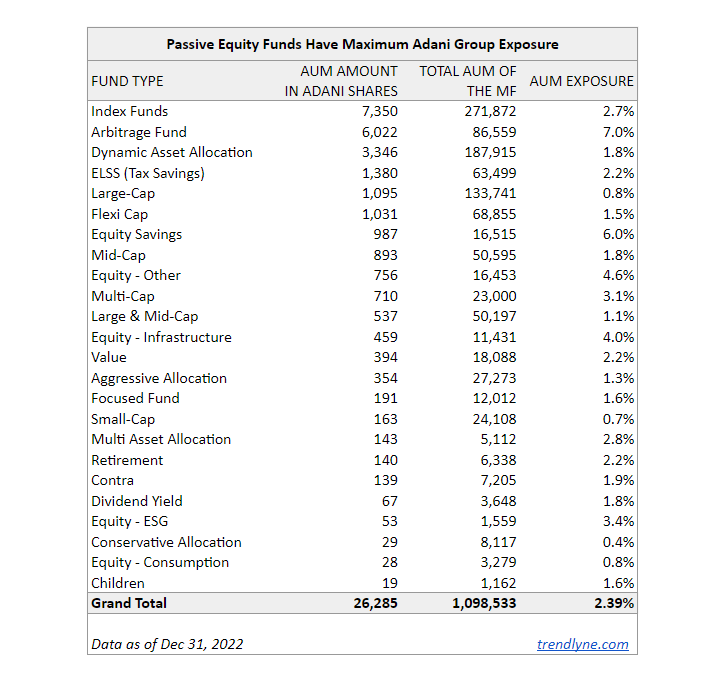By Shreesh Biradar
A recent research report by Hindenburg, a US-based research firm, has cast the spotlight back on India’s regulatory environment, through allegations of stock manipulation and questionable accounting practices by the Adani Group. Adani group shares have since lost nearly $40 billion market cap. While the group has rejected the allegations it has yet to address several of the points raised in the Hindenburg report, Investors are consequently wary. Most of the Adani stocks have lost more than a quarter of their value since the allegations came forth.

Note: Adani Group consists of the above set of stocks
The impact of the allegations on Adani stocks has been at varied degrees across investor segments. It affected mutual funds, Exchange Traded Funds (ETF) and banking stocks.
Higher passive mutual fund exposure to Adani shares
Equity mutual funds are exposed to the tune of Rs 26,285 crore towards Adani Group shares.The highest exposure has been to Ambuja Cements, ACC and Adani Ports, which constitute nearly 60% of the total exposure of mutual funds. Actively managed funds have stayed away from the Adani group as a whole, Fund managers are skeptical of its valuations and debt overhang.
Index funds which are passive in nature constitute nearly 28% of the exposure. As long as Adani stocks are part of Nifty Indices, ETFs cannot get into selling these stocks. Adani Ports and Adani Enterprises are part of Nifty 50, while Adani Green and Adani Transmission find their place in Nifty Next 50. Index funds are followed by arbitrage funds, which constitute nearly 23% of total mutual fund exposure towards the Adani group. These are mostly algorithm-driven with minimal human intervention.

Note: All values in Rs crore
Among fund houses, Quant Fund (11.07%) and Taurus Asset Management (10.90%) will have the biggest impact on NAV due to the Adani group fallout. While SEBI does not allow mutual funds to invest more than 10% of their portfolio in a single issuer, the guidelines are not clear when it comes to group entities.
Most big fund houses like HDFC, Axis, ICICI and SBI have stayed away from Adani group stocks, limiting their exposure below 4%.
Motilal Oswal and Kotak Mahindra have been the exception with 5.31% and 4.54% exposure respectively. Equity Mutual Funds have an exposure of 2.39%.

Note: All values in Rs crore
Nifty 50 index ETFs are having exposure of 2.09%, whereas Nifty Next 50 ETFs have 14%. The recent run-up of Adani group stocks has led to higher exposure of ETFs.
Funds with greater than 10%+ exposure have see a bigger drop in Net Asset Value
Among actively managed funds, Quant schemes feature in funds with greater than 10% exposure to Adani group. Mutual funds are designed to diversify investments, so even a concentrated 15-stock portfolio will not have more than 6-8% exposure to a single group.
Schemes with 10%+ exposure have seen NAV drop by 3-4%, considering the recent rout in Adani stocks. Even savings schemes, which are considered to be conservative and risk-averse, have seen a high degree of exposure to a single group.
 Note: All values in Rs crore
Note: All values in Rs crore
The recent sell-off in the market was dominated by the retail segment, while FPIs and mutual funds did not fully participate. Fitch group had cited concerns over Adani group’s leverage levels earlier. This was in August 2022, before the recent allegations broke out. Adani group, in response, had stated that they were in a sound financial position and reducing their debt levels. The recent allegations by Hindenburg are different as it’s not about the group’s financial condition but more about governance and misappropriation. Even though the group has denied the allegations, its stocks are still tumbling on the bourses.